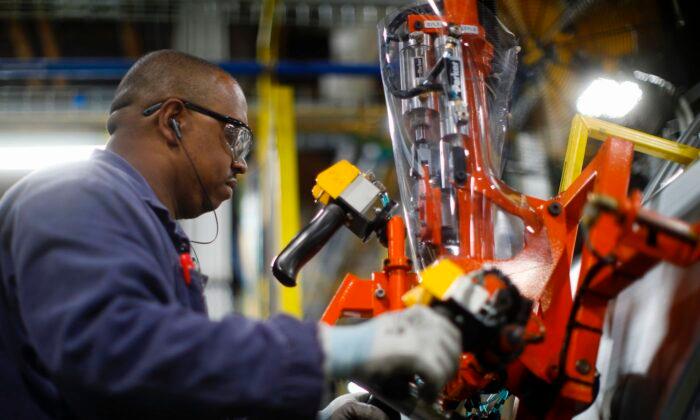The U.S. manufacturing sector weakened further to finish 2022 amid falling output and client demand, supporting widespread recession fears.
In December, the S&P Global U.S. Manufacturing Purchasing Managers’ Index (PMI) (
pdf) tumbled to 46.2, down from 47.7 in November; anything below 50 indicates contraction. This
matched Trading Economics’ expectations of 46.2.
It represented the largest monthly contraction in factory activity since May 2020, driven by slowing domestic client demand from inflationary pressures and economic uncertainty. Purchasing activity declined, while work order backlogs dropped sharply. Employment levels edged up slightly.
According to the PMI report, foreign demand trended lower on a stronger U.S. dollar and global economic concerns. As a result, new export orders eased at the slowest rate since September.
Although output expectations rose to a three-month high, businesses continued to be worried about the effects of inflation and slowing demand in the future.
“The manufacturing sector posted a weak performance as 2022 was brought to a close, as output and new orders contracted at sharper rates,” said Siân Jones, senior economist at S&P Global Market Intelligence, in the report. “With the exception of the initial pandemic period, stocks of purchases fell at the steepest rate since 2009.”
“Slower upticks in inflation signal the impact of Federal Reserve policy on prices, but growing uncertainty and tumbling demand suggest challenges for manufacturers will roll over into the new year,” she added.
The downward trends are not only concentrated in the U.S. manufacturing sector. The J.P. Morgan Global Manufacturing PMI (
pdf) highlighted that the international manufacturing industry continued its descent for the fifth consecutive month as output, new orders, employment levels, and worldwide trade volumes worsened in December.
Only seven of the 29 nations listed in last month’s report maintained a PMI print in expansion territory: India, Philippines, Russia, Mexico, Colombia, Indonesia, and Australia.
The next critical report will be the Institute for Supply Management’s (ISM) Manufacturing PMI. It is expected to drop further to 48.5, which would be down from 49 in November.
What Will Manufacturing Look Like in 2023?
The manufacturing sector is still going through a plethora of challenges, such as inflation, economic uncertainty, talent issues, and supply chain problems.“The industry is currently experiencing concerns related to inflation and economic uncertainty,” wrote Deloitte in its latest 2023
report. “In addition, manufacturers continue to grapple with talent challenges that may limit the industry’s growth momentum. Moreover, supply-chain issues, including sourcing bottlenecks, global logistics backlogs, cost pressures, and cyberattacks, will likely remain critical challenges in 2023.”
Despite these hurdles that might be hard to overcome, the ISM is optimistic about the manufacturing sector this year, citing rising revenues, growing capital expenditures, and capacity utilization.
“Manufacturing’s purchasing and supply executives expect to see overall growth in 2023. They are pessimistic about overall business prospects for the first half of 2023, but project growth returning in the second half,” the ISM Report On Business
stated last month.
Government subsidies in the global manufacturing sector could be another key trend in 2023.
This year, President Joe Biden and Congress recently approved the Inflation Reduction Act that included nearly $500 billion to enhance domestic manufacturing. This consisted of $437 billion in climate-related spending and almost $53 billion for a semiconductor-subsidy program.
China, the world’s second-largest economy, plans to
spend approximately $50 billion per year on its Made in China 2025 initiative. The program includes handing out government subsidies to 10 sectors, including aerospace, machinery, new energy vehicles, and railway equipment. Many large Chinese firms already receive hundreds of millions of dollars in subsidies, such as SAIC Motor, Sinopec, and the partially state-owned Semiconductor Manufacturing International Corp.
European Union leaders spent the better part of 2022 developing a “Made in Europe” campaign to counter the U.S. government’s efforts to spend hundreds of billions of dollars in manufacturing.
Commission President Ursula von der Leyen
proposed in a recent letter that changes to state subsidy rules should be implemented “to ensure a simpler, faster, and even more predictable state aid framework.” One of her ideas is a European Sovereignty Fund, though several bloc members are opposed to such a fund, including Austria and Denmark.
But could manufacturing fall short of expectations by the year’s end?
While speaking in an
interview with CBS' “Face the Nation,” International Monetary Fund chief Kristalina Georgieva warned that one-third of the global economy will slip into a recession this year, adding that “even countries that are not in recession, it would feel like recession for hundreds of millions of people.”
For the United States, the country might avoid a downturn and instead face a “slowcession,” says Moody’s Analytics chief economist Mark Zandi (
pdf).





